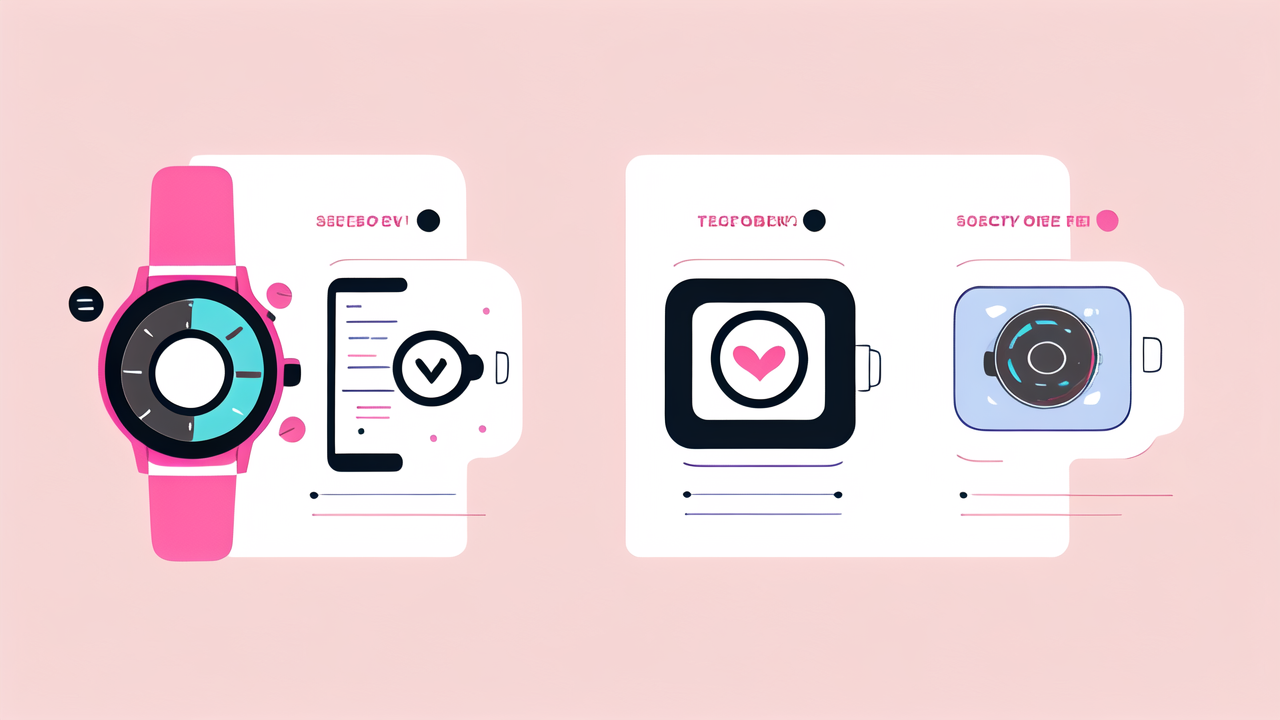The Dawn of Smart Watches and Health Tracking
Origins of Wearable Technology
Wearable technology has an intriguing debut, tracing back to inventions that bear little resemblance to today's sophisticated devices. Initially, wearable tech was not focused on health but on basic functionalities like time-keeping and basic computing. The first digital watch, created in the 1970s, served as the precursor to the evolution of smartwatches, laying the groundwork with its programmable features and ability to perform calculations. As technology advanced, these wrist-worn gadgets were seen as potential tools for enhancing personal efficiency. It wasn't until the late 2000s that health tracking began to emerge as a core feature of wearable devices, with some brands incorporating rudimentary step counters and calorie burn estimators. These early inklings of fitness tracking paved the way for a new era where monitoring health vitals became central to the development of smart watch technology.

Early Health Tracking Features
The initial smart watches introduced basic health tracking features that reshaped our approach to wellness and fitness. These watches often included simple pedometers, which counted steps and encouraged daily movement. Calorie counters began making their way onto our wrists, allowing users to estimate the amount of energy burned throughout the day. Additionally, some early models offered sleep tracking capabilities, providing insights into sleep patterns and quality. Even at this nascent stage, monitoring heart rate became a central focus, with optical sensors measuring pulse to give a rudimentary snapshot of cardiovascular health. These pioneering features laid the groundwork for the sophisticated health-tracking technology we have come to expect in modern devices. They marked the first steps in a journey towards a more connected and health-conscious lifestyle, propelled by wearable technology.
Advancements in Health Monitoring
Introduction to Fila's Role in Health Tech
Fila, a brand widely recognized for its sports and leisure apparel, has recently ventured into the health tech market with an emphasis on health monitoring through wearable devices. Their entry signifies the burgeoning interest of mainstream fashion companies in the realms of fitness and wellness technology. Fila’s foray into health tech is characterized by wearable devices that not only exhibit stylish designs but also encompass advanced features aimed at tracking health metrics such as heart rate, sleep patterns, and physical activity levels. By integrating cutting-edge sensors and algorithms within their smart watches, Fila has positioned itself as a formidable player within the health monitoring space, appealing to consumers who value both fashion and functionality in their quest for a healthier lifestyle.
Aura's Impact on Wearable Health Devices
Aura has made a significant contribution to the wearable health device industry. By prioritizing user-centric design and advanced biometric sensors, Aura's products have reshaped how individuals monitor their health. Wearable devices from Aura offer real-time data analysis, allowing users to gain insights into their own health metrics promptly. Additionally, Aura has focused on enhancing the accuracy of readings, which is critical for users to be able to rely on the information for making lifestyle or medical decisions. Their commitment to continuous innovation has spurred other companies to adopt new technologies and improve their health tracking features, lifting the entire market to new heights of functionality and reliability.
Key Features of Modern Smart Watches
Biometric Sensors and Their Functions
Modern smart watches are equipped with advanced biometric sensors that serve a multitude of functions. These sensors include heart rate monitors, which track your pulse throughout the day to give insights into your cardiovascular health. Another key feature is the accelerometer, which measures your daily steps and activity levels, aiding in fitness tracking. Skin temperature sensors can detect changes that may indicate fever or illness, while blood oxygen monitors measure your SpO2 levels, important for tracking respiratory health. Latest models have even begun to include ECG functionality, capable of detecting irregular heart rhythms. These sophisticated biometric sensors work in unison to provide a comprehensive overview of an individual's health status, making smart watches valuable tools for proactive health and fitness management.
Integration with Health Apps and Platforms
Modern smart watches have become powerhouses for health management largely due to their seamless integration with health apps and platforms. By syncing with specialized applications, these devices can monitor a wide range of health metrics, from daily step counts and heart rate to sleep patterns and oxygen saturation. These integrations allow for real-time data capture and sharing with medical professionals if needed, enabling proactive health management. Users can set goals, follow personalized workout routines, and receive notifications to stay hydrated or take medication. Moreover, compatibility with various OS platforms means no matter if you are an iPhone or Android user, your smart watch likely works in tandem with your phone to keep you in tune with your health.
User Experience and Interface Design
Navigating Health Data on a Smart Watch
A modern smart watch is a hub of health information, providing users with a wealth of data at their fingertips. However, the ease with which this data can be accessed and understood is critical. User interface design plays a pivotal role in the user experience, ensuring that the various metrics tracked, such as heart rate, steps taken, and sleep patterns, are presented in a clear and concise manner. Smart watches benefit from intuitive navigation systems, allowing users to swipe, tap, and scroll through their health data effortlessly. Visual elements like color-coded graphs and charts help in the quick identification of trends and anomalies within the health data. Moreover, timely notifications and summaries contribute to an engaging and informative user interaction, keeping users apprised of their health status without overwhelming them with complexity. The challenge for designers is to balance functionality with simplicity, making health tracking an integrated part of daily life rather than a cumbersome task.
Customization and Accessibility
When it comes to using smart watches for health tracking, the ability to personalize the device and ensure it's accessible for all users is crucial. Customization features allow individuals to set up their watches to monitor specific health metrics that matter most to them, from heart rate to sleep patterns. Users can also adjust goals and notifications to match their personal health plans. On the accessibility front, smart watches are now designed with diverse users in mind. This includes larger text options for easier reading, voice commands for hands-free operation, and haptic feedback for those with hearing difficulties. By offering a range of customization and accessibility options, smart watches provide a user-friendly experience that encourages regular interaction and ultimately, a healthier lifestyle.
Battery Life and Connectivity
Innovations in Power Efficiency
Long-lasting battery life is a crucial feature for smart watches, especially for those focusing on health tracking. Innovations in power efficiency play a significant role in providing users the freedom to track their health without worrying about frequent charging. Manufacturers have achieved this through various means: incorporating low-power displays like e-ink, optimizing software to manage resource-intensive tasks more efficiently, and using processors designed for wearables that consume less energy. Additionally, advancements such as solar charging capabilities and enhanced battery chemistry extend device longevity. These innovations not only offer convenience but also ensure that users can continuously monitor their health metrics around the clock.
Connectivity with Other Devices
Staying connected seamlessly is a vital aspect of modern smart watches, particularly when it comes to managing health data. Users expect their devices to work in harmony with a range of other gadgets, from smartphones to gym equipment. Smart watches can synch with smartphones for notifications, calls, and messages, ensuring that users never miss an important update. They also connect to fitness machines, like treadmills and stationary bikes, allowing for the sharing of workout data in real-time. With Bluetooth and Wi-Fi capabilities, watches can link to health apps on different devices, making it easy to track progress over various platforms. Manufacturers are constantly improving watch connectivity, enabling them to pair with a wider array of devices and thus enhancing the user's experience in monitoring and improving their health.
Privacy and Data Security Concerns
Addressing User Privacy in Health Data
As smart watches become increasingly intertwined with health tracking, consumers have grown mindful about the privacy of their health data. Manufacturers are stepping up efforts to ensure user privacy is a top priority. They achieve this through a variety of methods, such as anonymizing data, implementing strict authentication protocols, and obtaining user consent for data collection. Additionally, companies are reinforcing the importance of transparency, providing users with clear explanations of what health data is collected and how it is used. Multi-layered privacy settings also empower users to control their data sharing preferences. These measures help to address privacy concerns, building trust between consumers and technology providers.
Secure Data Transfer and Storage
As smart watches increasingly become a part of our daily lives, the secure transfer and storage of health data has emerged as a critical concern. Manufacturers are striving to ensure that data transmission from the watch to other devices and storage platforms is not only seamless but also protected against unauthorized access. They implement end-to-end encryption, which serves as a robust safeguard, encoding data as it travels to prevent potential interception. Additionally, many companies now offer secure cloud services, where user data is stored under stringent privacy regulations. These systems often include multiple layers of security, such as two-factor authentication and regular security audits, to protect sensitive health information. All of these measures aim to build consumer trust and comply with global data protection standards, like GDPR and HIPAA, ultimately ensuring that users can track their health metrics without compromising their personal privacy.
Market Trends and Consumer Demand
Consumer Expectations for Health Features
As the smart watch industry continues to innovate, consumer expectations for health features have exponentially increased. Users now seek more than just step counting and heart rate monitoring; they demand comprehensive health tracking capabilities. Wearers expect features that monitor sleep patterns, stress levels, and even nutritional intake. Advanced metrics like oxygen saturation, ECG, and blood pressure monitoring are becoming the norm. These desires aim to transform wrist wearables into holistic health management tools. Manufacturers pivot towards this trend, understanding that fulfilling these health-centric desires can drive market preference and brand loyalty.
Trends Influencing the Smart Watch Market
The smart watch market is rapidly evolving, driven by innovation and consumer appetite for new technology. Recently, several key trends have been shaping the industry. Consumers are increasingly seeking devices that offer comprehensive health monitoring capabilities, from tracking steps and heart rate to measuring sleep quality and stress levels. Furthermore, the integration of smart assistants and improved user interfaces have made smart watches more appealing across various demographics. The demand for stylish designs that blend seamlessly with personal fashion has also surged, leading to collaborations between tech companies and fashion brands. Additionally, there's a growing expectation for smart watches to be interoperable with a range of devices and ecosystems, so users can easily connect to their phones, home automation systems, and fitness equipment. Lastly, the growing awareness of personal health due to global events has seen a push for features that can track a wider array of health metrics, potentially offering early warnings for health issues. These trends showcase the dynamic nature of the smart watch market and hint at the potential directions for future product development.
The Future of Smart Watches in Health Tech
Predictions for New Health Tracking Capabilities
As the smart watch industry continues to grow, experts foresee exciting new health tracking capabilities on the horizon. Soon, we might see watches that can monitor blood glucose levels non-invasively, offering a boon for diabetics. Continuous stress monitoring, enabled by advancements in biometric sensors, could provide real-time insights into emotional well-being, potentially linking with mindfulness apps to offer solutions. Breakthroughs in artificial intelligence may lead to predictive health alerts, warning users of potential illnesses before symptoms manifest. Lastly, the integration of nanotechnology might enable hyper-accurate monitoring of vitals at the cellular level, opening up new possibilities for early disease detection. These predictions point to a future where smart watches will not only track health more comprehensively but also become proactive partners in managing and maintaining users' well-being.
The Potential Role of Fila and Aura in Future Developments
As the horizon of health tracking broadens, Fila and Aura are poised to play significant roles in shaping the future of smart watches. Fila, historically renowned for their athletic gear, may leverage its sportswear heritage to produce smart watches specifically tailored for fitness enthusiasts. These watches could offer advanced metrics for various sports and activities, complemented by durable designs that withstand rigorous workouts and outdoor conditions. Meanwhile, Aura, with its strengths in health tech innovation, might focus on holistic health monitoring. They could introduce features that provide insights into mental well-being, stress levels, and sleep quality, going beyond traditional physical health metrics. Both companies are expected to enhance the seamless integration of wearables with personal health ecosystems, incorporating AI-driven data analysis to offer personalized health recommendations. Together, Fila and Aura may redefine user expectations, making health tracking a more intuitive and integral part of daily life.




Leave a comment
This site is protected by hCaptcha and the hCaptcha Privacy Policy and Terms of Service apply.